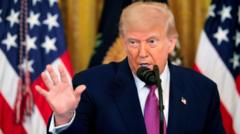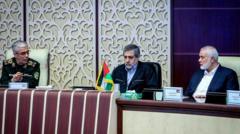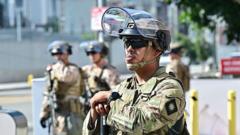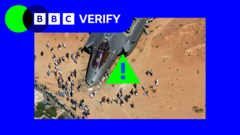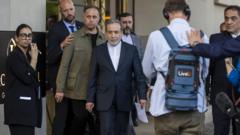President Trump's announcement signals a decisive shift in U.S. foreign policy, complicating prospects for peace.
U.S. Military Strikes Iran's Nuclear Sites, Escalating Tensions in the Middle East

U.S. Military Strikes Iran's Nuclear Sites, Escalating Tensions in the Middle East
The U.S. joins Israel in the battle against Iran, launching bombs on key nuclear facilities, with uncertain repercussions.
On June 21, 2025, President Donald Trump declared that the United States had bombed three vital nuclear sites in Iran, marking a significant escalation in U.S. involvement in Middle Eastern conflicts. The announcement was made via Trump's social media platform, Truth Social, at approximately 8 p.m. Washington time.
Trump's military action targeted the underground uranium-enrichment facility at Fordo, as well as other facilities in Natanz and Esfahan. In his statement, Trump boasted: “We have completed our very successful attack… All planes are now outside of Iran airspace. Congratulations to our great American Warriors. There is not another military in the World that could have done this.” He ended with a hopeful note for peace; however, the likelihood of diplomatic resolutions seemed uncertain given the context.
The decision to strike came just two days after Trump hinted at a forthcoming decision regarding military action. Israeli officials were informed prior to the attacks, and Trump later held a discussion with Israeli Prime Minister Benjamin Netanyahu about the implications of the strikes, according to a source who requested anonymity.
While the extent of the damage inflicted on Iran’s nuclear capability remains unclear, the ramifications of the assaults are expected to provoke Iranian retaliation, raising fears of a wider regional conflict. Within the Republican Party, reactions to the strike have varied, illustrating a division among lawmakers about the merits and potential consequences of further military engagement in the region.
Trump is scheduled to deliver a public address later tonight from the White House, aiming to clarify his stance amid mounting pressures from both supporters and critics regarding the military operation. As the situation unfolds, the international community watches closely, awaiting Iran's potential response and the U.S.'s next moves in an increasingly turbulent geopolitical landscape.
Trump's military action targeted the underground uranium-enrichment facility at Fordo, as well as other facilities in Natanz and Esfahan. In his statement, Trump boasted: “We have completed our very successful attack… All planes are now outside of Iran airspace. Congratulations to our great American Warriors. There is not another military in the World that could have done this.” He ended with a hopeful note for peace; however, the likelihood of diplomatic resolutions seemed uncertain given the context.
The decision to strike came just two days after Trump hinted at a forthcoming decision regarding military action. Israeli officials were informed prior to the attacks, and Trump later held a discussion with Israeli Prime Minister Benjamin Netanyahu about the implications of the strikes, according to a source who requested anonymity.
While the extent of the damage inflicted on Iran’s nuclear capability remains unclear, the ramifications of the assaults are expected to provoke Iranian retaliation, raising fears of a wider regional conflict. Within the Republican Party, reactions to the strike have varied, illustrating a division among lawmakers about the merits and potential consequences of further military engagement in the region.
Trump is scheduled to deliver a public address later tonight from the White House, aiming to clarify his stance amid mounting pressures from both supporters and critics regarding the military operation. As the situation unfolds, the international community watches closely, awaiting Iran's potential response and the U.S.'s next moves in an increasingly turbulent geopolitical landscape.




